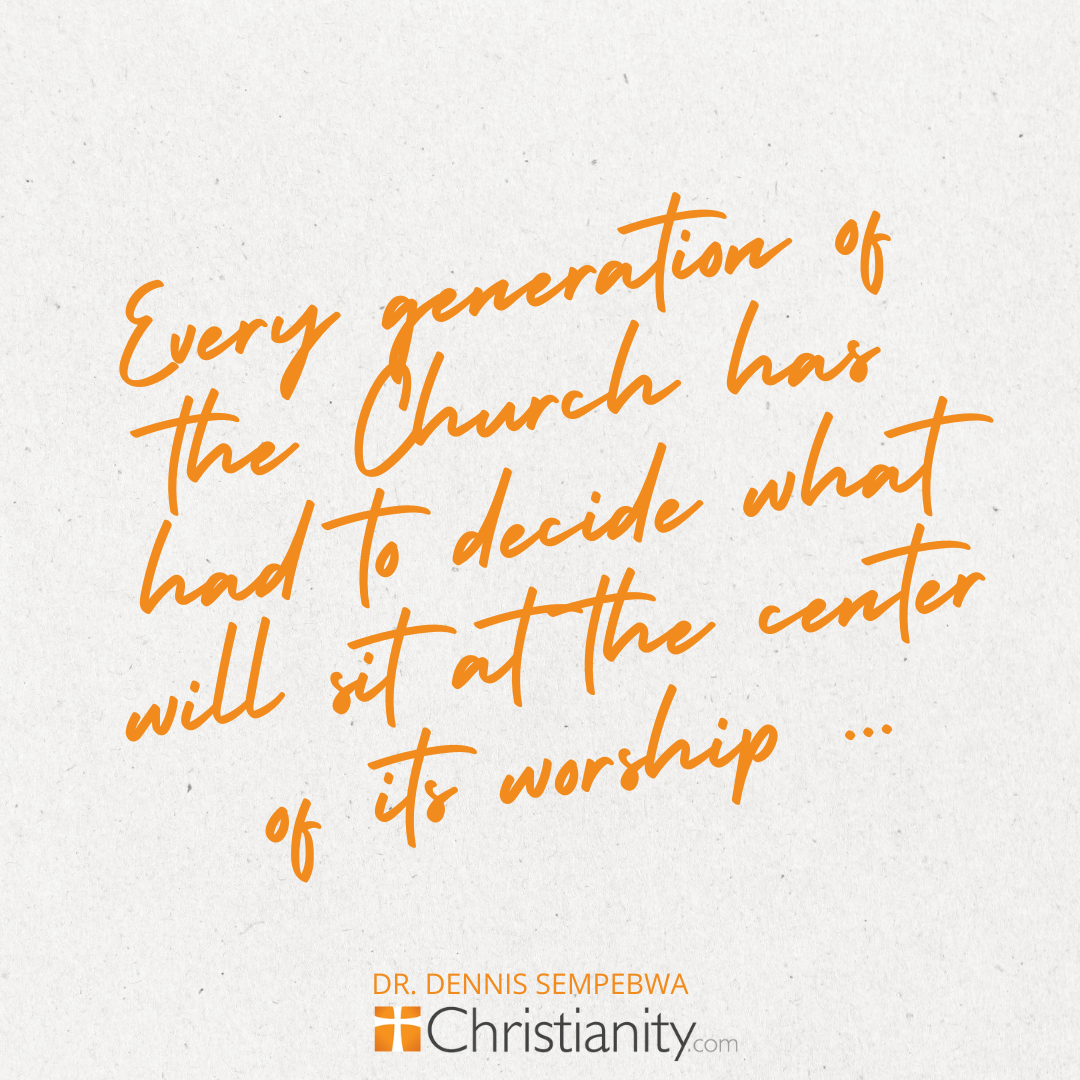Every generation of the Church has had to decide what will sit at the center of its worship: the unapologetic preaching of the Word, or the aesthetic power of music. Both are gifts of God. Both belong in Christian worship. But history—and our present moment—show how easily one displaces the other.
How Culture Rewrote the Sound of Worship
Architecture often reveals theology. In the 18th century, “auditory churches” were built so that everyone could hear the preacher. Triple-decker pulpits and galleries placed proclamation at the very center. Worship was anchored in the conviction Paul gave to Timothy: “Preach the word; be ready in season and out of season; reprove, rebuke, and exhort, with complete patience and teaching” (2 Tim. 4:2).
But by the 19th century, priorities shifted. The Oxford Movement re-centered attention on the altar, choir, and ritual. Great cathedrals began to boast of their magnificent organs, sometimes treating them as their most prized possessions. Entire sanctuaries were designed not for the voice of the preacher, but for the resonance of the instrument.
What Changed in Between? Several cultural forces converged to displace preaching:
Progressivism & Rationalism
The Enlightenment prized reason over revelation. Sermons were pressured to become moral lectures instead of prophetic proclamations.
Romanticism & Aesthetics
The 19th century emphasized beauty, emotion, and art. Organs, choirs, and architecture became the means of transcendence while sermons lost fire.
Secular Respectability
Churches sought cultural approval in increasingly secular societies, softening sermons that once carried prophetic rebuke.
Persecution & Pressure
In parts of Europe, state oversight or hostility caused pulpits to retreat into safer tones.
The result was predictable: when the pulpit grew quieter, the music grew louder.

The Return to Preaching in the 20th Century
The 20th century, however, witnessed a recovery of expository preaching, especially in evangelicalism:
Fundamentalist-Modernist Controversy
In response to liberal theology, preachers doubled down on the inerrancy of Scripture.
Revivalists like Billy Graham
Music prepared the crowd, but the sermon was always the climax. Graham would never let a crusade end without a clear call to repentance.
The Expository Movement
Leaders such as Martyn Lloyd-Jones, John Stott, James Montgomery Boice, and later John MacArthur revived confidence in verse-by-verse exposition. Seminaries built whole programs on it.
A World at War, a Church at the Pulpit
It was not only theological battles that restored the pulpit. The tumult of the 20th century also drove people back to preaching.
After the devastation of World War I, and again after the horrors of World War II—the Holocaust, the atomic bomb, entire nations in ruins—people longed for truth more solid than politics or progress. Modernism had promised utopia, but delivered trenches and genocide.
In that vacuum, the pulpit once again became a lifeline. The world did not need entertainment; it required a Word. Radio preachers, revivalists, and evangelists stepped into the moment. Billy Graham’s simple, clear sermons of salvation in Christ filled stadiums of people who were desperate for hope and moral clarity. While turmoil made pulpits necessary, prosperity, as we will see, made platforms entertaining.
The Swing Back to Worship-Centricity
But by the late 20th and into the 21st century, cultural and ecclesial forces pushed again in the opposite direction:
Charismatic Renewal
Brought fresh passion for worship and encounter, but sometimes at the expense of exposition.
Seeker-Sensitive Churches
Shortened, softened sermons for “unchurched” visitors, while music carried the service.
The Worship Industry
Hillsong, Vineyard, Bethel, and Passion have created a global economy around worship music, encompassing albums, tours, streaming, and licensing. Worship leaders became the icons of a generation.
Digital Culture
This is a growing phenomenon. While songs trend on Spotify and TikTok, sermons rarely do. As worship events sell out arenas, preaching conferences struggle.
And so, once again, music has eclipsed the Word.
When Music Prepared the Way for the Word
When I first became a Christian, the very first ministry I served in was worship. I loved singing. I still do. And as Africans, we love music. We love dance. We love movement. It was natural that we formed choirs, groups, and bands that filled our churches and streets with sound.
In time, I was honored to lead the foremost worship band in my country. Sixteen worshipers on stage, hours of music, whole nights filled with song. And yet—even then—we never forgot what anchored us. A typical night might include two hours of music, but there was always unadulterated preaching.
As worship director, I would consult with the pastor about what God had laid on his heart. Our music served the message. We were careful to ensure that the songs prepared people for the Word, not replace it. Worship was the spearhead of evangelism in our city, but proclamation was its weight.
That is why I look at today’s climate with shock. Too often, the music now drives the service. The sermon feels like an add-on. The pulpit has become the backdrop to the platform.
What Story Are Today’s Stadiums Telling?
The contrast is visible in our arenas. Hillsong, Passion, Elevation, and Chris Tomlin fill stadiums with tens of thousands for worship nights. Entire tours sell out on the promise of song. But when was the last time a stadium was filled to hear unapologetic expository preaching? Streaming platforms and licensing companies have built a global industry around worship music. Churches invest heavily in sound systems, lighting rigs, and production teams. Preaching does not chart on Spotify. It does not trend on YouTube. It does not sell tickets. And so in many places, it quietly recedes to the margins.
Yet Paul’s reminder still stands: “How are they to believe in him of whom they have never heard? And how are they to hear without someone preaching?” (Rom. 10:14).
The Danger of a Wordless Faith
This trend is not harmless. A church that sings without hearing is a church that feels God but does not know Him. Songs can indeed teach—Paul instructed believers to “let the word of Christ dwell in you richly… singing psalms and hymns and spiritual songs” (Col. 3:16). But when music becomes the meal rather than the servant, doctrine grows thin. Worship drifts into therapy. People leave with a melody in their head but no anchor in their soul.
The Reformers knew this danger well. That is why they fought to return the pulpit to the center. Luther wrote hymns, but they served proclamation. Calvin restricted instruments to protect the primacy of the Word. They understood what we are in danger of forgetting: without proclamation, the Church drifts.
When Worship Bows Again to the Word
Worship leaders today stand at a crossroads. Will the songs they select lead people to feel, or will they also lead them to hear? Will they choose songs that catechize, not just entertain? Can they let the setlist be guided by the sermon text, not the chart-toppers? Psalm 96: “Sing to the Lord, bless his name; tell of his salvation from day to day. Declare his glory among the nations.” Your task is not only to stir the emotions of a crowd, but to sing the truth of God into their bones.
Pastors, the responsibility rests with us as well. We must guard the pulpit. We must not let music overshadow Scripture. We should invest in preaching with the same energy we invest in production. This means that we preach even when people prefer to sing. Paul could say to the elders of Ephesus: “I did not shrink from declaring to you the whole counsel of God” (Acts 20:27). May we say the same.
Music is a gift. But when music takes the throne, it becomes an idol. The Church was not birthed by song but by the Word proclaimed with fire and authority. At Pentecost, there was no band to warm up the crowd. Instead, “Peter, standing with the eleven, lifted up his voice and addressed them” (Acts 2:14). And when the sermon was over, “they were cut to the heart” (Acts 2:37).
It is time for worship to bow again to the Word. For in the end, faith does not come by singing. Faith comes by hearing, and hearing through the word of Christ (Rom. 10:17).
A Prophetic Caution
One last word of warning. In the 20th century, following two world wars that shook the nations, the Church turned its attention back to the pulpit. A wounded world demanded a Word from God, and preaching rose again to the center. But in the 21st century, after the global disruption of COVID, the response has been tragically different. Instead of returning to proclamation, much of the Church has doubled down on worship-centricity—chasing the sound, the stage, and the song, while the pulpit grows ever quieter.
If history teaches us anything, it is that crisis is meant to drive us back to truth, not deeper into distraction. Unless we recover the primacy of preaching now, we risk raising a generation that knows how to sing to God, but not how to listen to Him.
Photo Credit: ©Sparrowstock/David Clark





